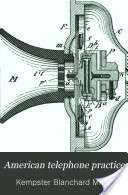Kempster Blanchard Miller
Kempster Blanchard Miller (August 14, 1870 – November 22, 1933) was an American engineer, author, and businessman. He is known for his many writings in the field of electrical engineering, electrical design, and the early telephone industry. His best known work was American Telephone Practice, considered for many years to be the seminal textbook on early telephone design and function.[1]
Kempster Blanchard Miller | |
|---|---|
| Born | August 14, 1870 Boston, Massachusetts, U.S. |
| Died | November 22, 1933 (aged 63) Pasadena, California, U.S. |
Personal life
Miller was born in Boston, Massachusetts to Joseph Kempster Miller and Eliza (Blanchard) Miller, he spent his childhood in Washington, DC before earning his engineering degree from Cornell University in 1893. In 1897 he married Antha Knowlton, and they had three daughters, Dorothea, Antha, and Ruth.
Notable Family Members
Daughter Ruth Miller, also known as Ruth Kempster and Ruth Blanchard Miller, was a distinguished artist whose work was exhibited (and won a silver medal) in the 1932 Olympics.
His brother was businessman, rancher and citrus farmer Azariel Blanchard Miller (1878–1941), founder of the city of Fontana, California.
Career
After graduating from Cornell, Miller worked for a time in the US Patent Office as an examiner, then worked as an electrical engineer for the Western Telephone Construction Company. Later, as Chief Engineer in the Kellogg Switchboard & Supply Company[2] he was an unwitting accomplice to the secret takeover by the Bell Telephone Company, reversed after a lawsuit by the company's founder, Milo G. Kellogg.[3] He then formed his own engineering consulting company with Samuel McKeen in 1905 in Chicago, Illinois[4]
American Telephone Practice
In 1899 American Electrician published Miller's book, American Telephone Practice. At 518 pages and many dozens of illustrations, it detailed nearly everything known about the telephone industry at the time. Three more printings followed, in 1900, 1903 and 1905. The last two editions were published by McGraw. By the last edition (1905), entirely updated and rewritten, it had grown to 888 pages.

Philanthropy
Credited in 1928, along with F.R. Welles and Charles A. Brown, with donating 100 acres of land that would become Pilot Butte State Scenic View in Bend, Oregon.[5]
Death
Miller died on November 22, 1933 in Pasadena, California, at the age of 63.[6]
References
- De Land, Fred B.; McMynn, John C.; Perrine, Frederic Auten Combs; Kammeyer, Carl E. (2007-09-25). Telephone magazine: an illustrated ... - Google Books. Retrieved 2010-12-22.
- "When Western Electric Secretly Controlled Kellogg". Telephonecollectors.org. Archived from the original on 2010-12-01. Retrieved 2010-12-22.
- "When Western Electric Secretly Controlled Kellogg". Telephonecollectors.org. Archived from the original on 2010-12-01. Retrieved 2010-12-22.
- Goodspeed, Weston Arthur; Healy, Daniel David (2008-07-22). History of Cook County, Illinois ... - Google Books. Retrieved 2010-12-22.
- "Pilot Butte State Scenic Viewpoint | Oregon Encyclopedia - Oregon History and Culture". Oregon Encyclopedia. 2007-11-21. Retrieved 2010-12-22.
- "Obituary: Kempster Blanchard Miller", Electrical Engineering, IEEE: 234–235, doi:10.1109/T-AIEE.1934.5056511